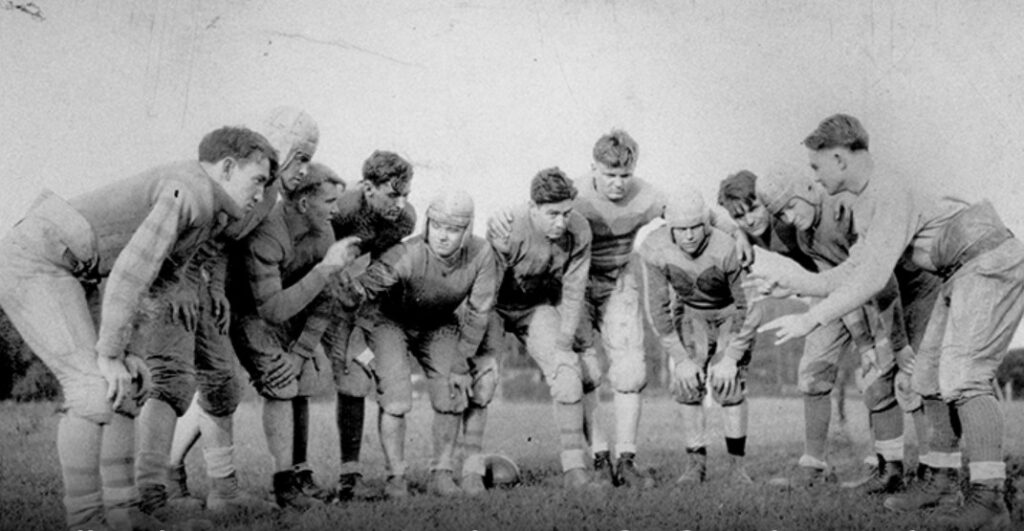
It’s football season, and in the South, there is no other topic this time of year!
American gridiron football evolved from soccer and rugby and was first played in 1869, in a game between Princeton and Rutgers. By the 1890s it had become a game we would easily recognize with a snap, downs, and many of the rules we are used to today. There were no huddles; teams typically just stood far away from the opposing team, so that their discussion could not be heard.
So, where did the huddle come from? In 1856, a new school opened in Washington, DC, the Columbia Institution for the Instruction of the Deaf and Dumb and Blind. Later named Galludet, it continues today as a prestigious university and remains the only higher education institution in which all programs and services are specifically designed to accommodate deaf and hard of hearing students.
In 1894, Paul Hubbard, the Galludet quarterback, was known as “the Eel” for his slippery maneuvers. The Galludet Bisons played against other deaf teams, and Paul realized their signals, in sign language, could be easily intercepted by the opposing team. He had his players form a tight circle around him as he signed information about upcoming plays. They went on to have a winning season, 5-2-1, beating the Pennsylvania School for the Deaf and the New York School for the Deaf.
It wasn’t long before teams who had players with normal hearing took notice; Oregon State pioneered this new huddle idea to great advantage, and by the 1920s, the huddle was standard everywhere. In 1941, Hubbard was honored by Galludet and Kansas School for the Deaf (where he coached for years) as “the daddy of the huddle”.
Other football players with physical limitations have made significant changes in the game. Tom Dempsey (1947–2020) was born without toes on his right foot and without four fingers on his right hand. This never slowed him down; he played football, wrestled and threw shot put in high school. He had a custom shoe made for his right foot, with no toe box and a square front tip. He played as a placekicker in the NFL for the New Orleans Saints, Philadelphia Eagles, Los Angeles Rams, Houston Oilers, and Buffalo Bills. It was when he was with the Saints in 1970 that he kicked a 63-yard field goal, a record that wasn’t broken until 40 years later. The kick, as time expired, gave the Saints a 19-17 win over the Detroit Lions. There was a lot of controversy about his custom shoe with the flat end, and whether it gave him an unfair advantage. His answer to that question was, “”Unfair, eh? How ’bout you try kickin’ a 63-yard field goal to win it with 2 seconds left an’ yer wearin’ a square shoe, oh yeah, and no toes either.” In a 1972 victory over the Houston Oilers, he scored all the Eagles’ 18 points with six field goals–a team record that still stands.
In 1977, the NFL added a rule, informally known as the “Tom Dempsey Rule”, that “any shoe that is worn by a player with an artificial limb on his kicking leg must have a kicking surface that conforms to that of a normal kicking shoe.” This rule didn’t really apply to Dempsey, who did not have an artificial limb, and he was allowed to continue to use his custom shoe.
Dempsey went on to have a successful football career playing as placekicker as well as defensive lineman for 11 years in the NFL. He was awarded the George Halas Award in 1971, given to a “player who has overcome adversity to succeed in the NFL”.
We can’t talk about football and medical issues without mentioning CTE, Chronic Traumatic Encephalopathy. It’s a complex issue far beyond the scope of my short blog, but suffice it to say that according to a 2017 study of brains of deceased gridiron football players, 99% of tested brains of NFL players, 64% of semi-professional players, 91% of college football players and 21% of high school football players had various stages of CTE. (Have you seen the 2015 movie, Concussion, starring Will Smith?) In addition to overhauling the concussion policy and pledging several million dollars to concussion and brain injury research, the NFL has spearheaded redesigning helmets to try to mitigate injuries from repeated tackles. Significant research has gone into new helmet development, studying linear and rotational shear and deceleration forces. Soft shell helmet covers called Guardian Caps have been introduced, and the NFL allows all players to wear them during games, and mandates them during practice. The NFL says concussions have decreased by 50% with the Guardian Caps, however biomedical engineers at Virgina Tech’s Helmet Lab say the reduction is more in the 5-14% range. Studies at University of North Carolina and University of Nevada, Reno have been disappointing, showing little to no difference in the forces delivered with each tackle with padded helmets. Will these helmets make a clinical difference? It’s still unclear, but many colleges are using these padded helmets now. It’s a work in progress, but you are going to see more of these larger “mushroom cap” helmets as time goes by, I am sure.
So, as we cook hotdogs for tailgate parties and stream into football stadiums to cheer on our favorite teams this fall, let’s remember these special players and the medical issues that changed the sport.
Ann,
Interesting information about the huddle and CTE. With the popularity of youth football and soccer, I wonder if the onset of CTE is occurring earlier in life? Are pediatricians seeing early CTE?
I think the answer is yes, but there’s not much real data. https://www.cnn.com/2023/08/28/health/cte-younger-athletes
Great post, Ann, and again, my fund of knowledge has increased as a result of what you wrote! I am continually amazed at these really cool historical details you unearth; you’re like a magician!
Great to hear from you! So glad you enjoyed this.